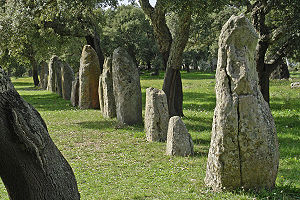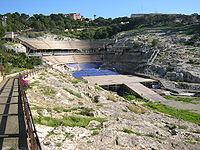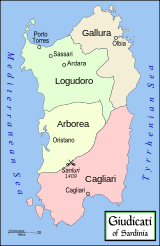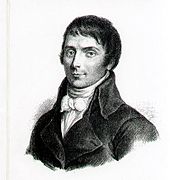- History of Sardinia
-
Archaeological evidence of prehistoric human settlement on Sardinia island is present in the form of the nuraghe which dot the land. The recorded history of Sardinia begins with its contacts with the various people who sought to dominate western Mediterranean trade in Classical Antiquity: the Egyptians, Phoenicians, and Romans. Initially under the political and economic alliance with the Phoenician cities, it was colonised and then conquered by Rome during the First Punic War (238 BC) but strong Punic cultural influences remained until the 1st century AD.
In the Early Middle Ages, through barbarian movements and the waning of Roman (by this time Byzantine) authority, the island fell out of the sphere of influence of any higher government. Saracen raids provided an impetus for the creation of independent[citation needed], quasi-royal giudicati in the 8th through 10th centuries. Falling under papal influence, Sardinia becomes the focus of the rivalry of Genoa and Pisa and finally of the local population and the Crown of Aragon, which subsumed the island as the Kingdom of Sardinia in (1324), which was to last until 1720 when it was acquired by the House of Savoy, which later, in 1861, became the Kingdom of Italy and finally the Republic of Italy.
Contents
Prehistory
Nuragic sculpture (Cagliari, Archeological Museum)
The most ancient human trace in Sardinia could be referred to the discovery of the fossil of an Oreopithecus bambolii, a prehistoric anthropomorphic primate, dated 8.5 million years ago. In 1979 human remains were found that were dated to 150,000 BC[citation needed]. In 2004, in a cave in Logudoro a human finger bone was found that was dated up to 250,000 BC[citation needed].
Prehistoric arrowheads (3rd millennium BC) and figurines demonstrate a well-developed industry of stone carving.
Already in the Stone Age, Monte Arci played an important role. The old volcano was one of the central places where obsidian was found and worked for cutting tools and arrowheads. Even now the volcanic glass can be found on the sides of the mountain. The Archeological Museum of Sassari displays ceramics from the Copper or Aneolithic Age (2600 BC).
Pre-historic and Pre-nuragic constructions that characterise the Sardinian landscapes are the Domus de Janas (Sardinian:House of the Fairies or of the Witches), the Giants' graves, the Betili (Sardinian: Menhir), Dolmens and Holy wells.Nuragic Era
Main article: Nuragic civilizationPrehistoric Sardinia is characterised by stone structures called nuraghe, of which there are more than 8,000. The most famous is the complex of Barumini in the province of Medio Campidano. The nuraghe were mainly built in the period from about 1800 to 1200 BC, though many were used until the Roman period. Next to these were built holy water-places (for example Santa Cristina, Sardara) and dolmens.
It is known that the Sardinians had contact with the Myceneans, who traded with the western Mediterranean. Contact with powerful cities of Crete, such as Kydonia, is clear from pottery recovered in archaeological excavations in Sardinia.[1] The alleged connection with the Sherden, one of the sea peoples who invaded Egypt and other areas of eastern Mediterranean, has been supported by professor Giovanni Ugas from the University of Cagliari; this hypothesis has been however opposed by other archaeologists and historians[2]
The name Sardinia derives from that of Sardus (known amongst the Roman as Sardus Pater), a mythological hero of the Iolei, one of the Nuragic tribes.
Early and Classical Antiquity
Phoenician settlement
From the 8th century BC, Phoenicians founded several cities and strongholds on south west of Sardinia; Tharros, Bithia, Sulcis, Nora and Karalis (Cagliari). The Phoenicians came originally from what is now Lebanon and founded a vast trading network in the Mediterranean. They settled along the south western coasts. Sardinia had a special position because it was central in the Western Mediterranean between Carthage, Spain, the Rhone river and the Etruscan civilization area. The mining area around Iglesias was important for the metals lead and zinc. The cities were founded on strategic points, often peninsulas or islands near estuaries, easy to defend and natural harbours. After the Phoenicians, the Carthagianians took over control in that part of the Mediterranean, around 550 BC. They expanded their influence to the eastern and southern coast from Bosa to Karalis, consolidating a large number of Phoenician colonies all over the western Mediterranean under one empire for the first time. The cities were administered by plenipotentiaries called Sufetes, which stressed the growing of grain and cereals.
Roman Empire
In 240, in the course of the First Punic War, the Carthaginian mercenaries on the island revolted and gave the Romans, who some years earlier had defeated the Carthaginians in the sea off Olbia and had occupied Sulci, the opportunity to land on Sardinia and occupy it. In 238 BC the Romans took over the whole island, without meeting any resistance. They took over an existing developed infrastructure and urbanized culture (at least in the plains). Along with Corsica it formed a province under a praetor.[3] Together with Sicily it formed one of the main granaries of Rome until the Romans conquered Egypt in the 1st century BC.
A revolt, led by two Sardo-Punic nobles, broke out after the crushing Roman defeat at Cannae (216 BC). A Roman army of 23,000 men, under Titus Manlius Torquatus, met the Carthagianian-Sardinian allied forces in the south of the island, defeating them and killing 12,000 men. The so-called Sardi Pelliti ("Fur-covered Sardinians") living in the impervious mountains of the interior resisted the Roman colonization for more than a century, Marcus Caecilius Metellus subduing them only in 127 BC.
Under Roman domination, Latin became the speech of the majority of the inahbitants, ultimately developing in to the modern Sardinian language. The Punic culture remained very strong under the Romans until the 1st centuries AD. Tharros, Nora, Bithia, Antas and Monte Sirai are now important archaeological monuments where architecture and city planning can be studied.
During the Roman period, the geographer Ptolemy noted that Sardinia was inhabited by the following peoples, from north to south: the Tibulati and the Corsi, the Coracenses, the Carenses and the Cunusitani, the Salcitani and the Lucuidonenses, the Æsaronenses, the Æchilenenses (also called Cornenses), the Rucensi, the Celsitani and the Corpicenses, the Scapitani and the Siculensi, the Neapolitani and the Valentini, the Solcitani and the Noritani.[4]
Middle ages
Vandals, Goths and Byzantines
After the fall of the Western Roman Empire, Sardinia was subject to several conquests. In 456, the Vandals, an East Germanic tribe, coming from North Africa, occupied the coastal cities of the island. A brief Eastern Roman reconquest did not last long, and the Vandals imposed garrisons guarded by African auxiliaries, like the Mauri. In 533, Sardinia rebelled under Goddas, a Goth.
In 534 the small Vandal forces surrendered immediately to the Byzantines when news of the Vandal collapse; thenceforth the island was part of the Byzantine Empire, included in the African prefecture. The local governor sat in Caralis. During the Gothic Wars much of the island fell easily to the Ostrogoths, but an army sent from Carthage and the final fall of German resistance in the mainland reassured the Byzantine control.
One of the few ethnic Sardinians known from this period was one Ospitone, a leader of the Barbaricinos (people of Barbagia). According to the Pope Gregory I's letters, in the island co-existed a Romanized and Christianized area (that of the provinciales) with, in the interior, pagan or semi-pagan cultures (Gens Barbaricina). The ruler of one of the latter, Ospitone, converted to Christianity in 594 after a diplomatic exchange. Christianization however remained for long influenced by eastern and Byzantine culture.
Saracens raids
Further information: Pisan–Genoese expeditions to Sardinia (1015–1016)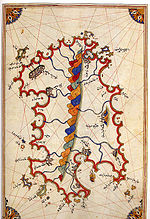 Historic map of Sardinia by Piri Reis.
Historic map of Sardinia by Piri Reis.
Starting from 705–706, the Saracens from North Africa (recently conquered by the Arab armies) harassed the population of the coastal cities. News about the political situation of Sardinia in the following centuries is scarce. Due to Saracen attacks, in the 9th century Tharros was abandoned in favor of Oristano, after more than 1800 years of occupation; Caralis, Porto Torres and numerous other coastal centres suffered the same fate. There was news of another massive Saracen sea attack in 1015-16 from Balearics, led by Mujahid (Latinized in Museto), the saracen's attempt of invasion of the island was stopped by Sardinian Giudicati with the support of the Fleets of Maritime Republics of Pisa and Genoa. Pope Benedict VIII asked the aid of the maritime republics of Pisa and Genoa in the struggle against the Arabs.
Giudicati
Main article: Giudicati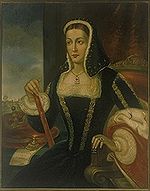 Eleanor of Arborea, Sardinian judge
Eleanor of Arborea, Sardinian judge
From the mid-11th century the Giudicati ("held by judges") appeared. The title of "iudike" (judge) was an heir of that of the Byzantine governor after the creation of the Exarchate of Africa in 582 (Prases or Judex Provinciae). In the 8th–9th centuries the four partes depending from Caralis grew increasingly independent, the Byzantines being totally cut off from the Tyrrhenian Sea by the Muslim conquest of Sicily in 827. A letter from Pope Nicholas I in 864 mentions for the first time the "Sardinian judges", their autonomy now clear in a later letter by Pope John VIII, which defined them as "Princes".
At the dawn of the judicial era Sardinia had some 330,000 inhabitants, of which 120,000 were free. These were subjected to the authority of local curators (administrators), in turn subjected to the judge (who also administrated justice and was the commander of the army). The church was also powerful, and at this time it had completely abandoned the Eastern Rite. The late 11th century arrival of Benedictine, Camaldolese and other monks from the Mezzogiorno, Lombardy, and Provence, especially the monasteries Montecassino, Saint-Victor de Marseille, Vallombrosa, boosted the agriculture in a land which was extremely underdeveloped. The Condaghi (catalogues, cartularies) of the monasteries, which record property transactions, are an important source for the study of the island in the 11th and 12th centuries. Evidence from the Condaghi of San Pietro di Silki, in Sassari, and Santa Maria di Bonarcado concerning the children of slaves has been adduced to show that differences in agricultural lifestyles between regions may affect the survival rate of females, hypothetically through increased infanticide of baby girls.[5] The abbacy of Santa Maria di Bonarcado contained more central, upland regions where a pastoral economy dominated and women were less economically useful; among children in that region, sex ratios are highly skewed in favour of men. On the other hand, in the region of San Pietro di Silki, less pastoral, child sex ratios are not skewed abnormally.
There were five (historically known) Giudicati: Agugliastra, Logudoro, Cagliari, Arborea and Gallura. Agugliastra was early on absorbed by Cagliari and Arborea and Logudoro (and perhaps Gallura) were united for a time in the 11th century.
 Basilica di Saccargia, the major example of Pisan Romanesque in Sardinia
Basilica di Saccargia, the major example of Pisan Romanesque in Sardinia
The initiatives of the Gregorian reformers led to greater contact between Sardinia and the continent, especially through the desires of the judges to establish monasteries with monks from continental monasteries at Montecassino and Marseille. By the 12th century, the Sardinian Giudicati, though obscure, are visible through the mists of time. They professed allegiance to the Holy See, which put them under the authority of the Archdiocese of Pisa, superseding the ancient primacy of the Archdiocese of Cagliari on the island. Some historians have even hypothesised that Sardinia was more or less a theocracy under the Cagliaritan diocese until their power was replaced by the Pisan.
Often warring between one another, the Giudicati made a great number of commercial concessions to the Pisans and the Genoese. The Repubbliche Marinare soon became the true masters of the Sardinian economy.
In the late 12th century and early 13th century, all four Giudicati passed to foreign dynasties and the local families were relegated to minor positions. Arborea passed to the Catalan House of Cervera (Cervera-Bas) in 1185, though this was contested for the next few decades. In 1188, Cagliari was conquered by the House of Massa from the Republic of Pisa. Gallura became by marriage — it had been inherited by a woman, Elena — a possession of the House of Visconti, another Pisan family, in 1207. Only Logudoro survived to the end under local Sardinian rulers. However, its end was early. It passed to Genoa in 1259 after the death of its last judge (Giudicessa), Adelasia, only a year after the Pisans deposed the last ruler of Cagliari. Gallura survived longer, but the enemies of the Visconti in Pisa soon removed the last judge, Nino, a friend of Dante Alighieri, in 1288.
About the same time, Sassari declared itself a free commune allied to Genoa. In the early 14th century, much of Eastern Sardinia was under Pisan authority. Arborea, however, survived until 1420. The most remarkable Sardinian figure of the Middle Ages, Eleanor of Arborea, was co-ruler of that region in the late 14th century; she laid the foundations for the laws that remained valid until 1827, the Carta de Logu.
Kingdom of Sardinia
Main article: Kingdom of SardiniaKingdom of the Crown of Aragon
Main article: Kingdom of Sardinia and Corsica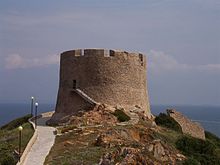 Aragonese tower in Santa Teresa di Gallura
Aragonese tower in Santa Teresa di Gallura
In 1323 the Catalan, under Peter, son of King James II, disembarked near Iglesias, in Southern Sardinia. The Pisane intervened but were defeated both by sea and land, and were forced to leave the Cagliari area as well as Gallura, maintaining only their castle in Carali. In 1353 Marianus IV of Arborea, allied with the Doria family, waged war against the Catalan, defeating them at Decimum and besieging Sassari, but unable to capture Cagliari. The Peace of Sanluri (1355) ushered in a period of tranquillity, but hostilities were resumed in 1395, with Arborea initially able to capture much of the Island. However, in 1409 the Aragonese crushed a Genoese fleet coming in support the Sardinians, and destroyed the Giudicato army at the Battle of Sanluri. Oristano, the Arborean capital, fell on March 29, 1410. The last Giudice of Arborea sold his remaining territories in 1420, in exchange for 100,000 florins.
The watchtowers all along the coast are called Catalan Towers and served to protect the island against the Arab incursions. Some of these towers were built with the stones of the Phoenician cities because they lay on strategic sites. A nice example of re-use for secular and ecclesiastical architecture can also be found in the church of Santa Giusta where the old city of Othoca had been.
The loss of the independence, the firm Catalan (later Spanish) rule, with the introduction of a sterile feudalism, as well as the discovery of the Americas, provoked an unstoppable decline of Sardinia. A short period of resurgence occurred under the local noble Leonardo Alagon, marquess of Oristano, who managed to defeat the viceroyal army in the 1470s but was later crushed at the Battle of Macomer (1478), ending any further hope of independence for the island. The unceasing attacks from North African pirates and a series of plagues (from 1582, 1652 and 1655) further worsened the situation. In 1637 a French fleet sacked Oristano.
Sardinia was disputed between 1700 and 1720. After it was assigned to Emperor Charles VI in 1714, Philip V of Spain briefly recovered the island in 1717, but in 1720 the European powers assigned Sicily to Charles VI and Sardinia to the House of Savoy, so Vittorio Amedeo II became the King of Sardinia.
Piedmont-Sardinia
Main article: Piedmont-SardiniaThe 28 of April 1794, two Piedmontese officials were killed in Cagliari during an uprising. It was the first act of a revolt (later referred to as "Anti-Feudal Movement" or "Sardinian Revolutionary Movement"[citation needed]) all over the island that culminated in the expulsion of the tyrants[citation needed]. The 28 of December 1795, a group of insurgents, mainly coming from the region called Logudoro to demonstrate against feudalism, occupied the city of Sassari. The 13 of February 1796, in order to suppress a riot, the viceroy Filippo Vivalda gave to the Sardinian magistrate Giovanni Maria Angioy the title of Alternos and the role of a substitute of the viceroy himself. Angioy moved from Cagliari to Sassari and, during the journey, almost all the villages started an uprising, asking for the end of feudalism and the independence of Sardinian people[citation needed].
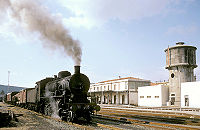 Historical steam locomotive in Macomer
Historical steam locomotive in Macomer
In 1799 King Victor Emmanuel I was ousted from Piedmont by the French army, and moved his court to Cagliari (the King returned to Turin only in 1814). At the end of 18th century, the Universities of Sassari and Cagliari were restored. In 1823, Victor Emmanuel I issued the "Editto delle Chiudende", a legislative act that abolished all community latifundias, introducing the public property[citation needed]. In 1847, under King Charles Albert, the Perfect fusion between Sardinia and Piedmont was supposed to grant equal rights to the inhabitants of the two regions of the Kingdom[citation needed].
New infrastructures were built under King Carlo Felice. The main road from the south (Cagliari) to the north (Sassari) was enhanced (the road still exists today and it still bears the name of Carlo Felice). Also, the first ferry route between the island and Genoa was established, using steamboats such as the Gulnara. The first railway was inaugurated in 1871. By the end of the century the Royal Railways had received 30 locomotives, 106 passenger cars, and 436 cargo cars. New urban plans and new villages (for example Santa Teresa di Gallura) were realised. They often followed the urban model of Turin, which now was the capital of the Reign of Italy. The economy was focused mainly on the primary sector (agriculture and sheep husbandry) and on mining. The majority of mining societies operating in Sardinia depended on non-Sardinian capital money. However, in 1848 the Sardinian entrepreneur Giovanni Antonio Sanna achieved the property of the mine of Montevecchio, thus becoming the 3rd richest man of the Kingdom.
United Italy
Kingdom of Italy
With the Unification of Italy in 1861, the Kingdom of Sardinia became the Kingdom of Italy. In 1883 the first train travelled between Cagliari and Sassari.
During the first world war the Sardinian soldiers of the Brigata Sassari distinguished themselves, with several being decorated with gold medals and other honours. Following the war, Italian Parliament passed a bill (called la legge del milione) to establish a budget of one million lire to develop infrastructure in order to encourage economic development. However, only a portion of the designated funds were ever distributed.
The writer Grazia Deledda won Nobel Prize for Literature in 1926.
During the fascist period, and implementation of the policy of autarky, several swamps were reclaimed around the island and agrarian communities founded. The main communities were in the area of Oristano, where the village of Mussolinia (now called Arborea) was located, and in the area adjacent the city of Alghero, within the region of Nurra, Fertilia was founded. Also established during that time was the city of Carbonia, which became the main centre of mining activity. Works to dry the numerous waste lands and the reprise of mining activities favoured the arrival of settlers and immigrants, from Veneto, and after the World War II Istrians and Dalmatians, from Yugoslavia.
The repression by the fascist regime of its opponents within the region was ruthless. Antonio Gramsci, one of the founders of Italian Communist Party, was arrested and died in prison. The anarchist Michele Schirru was executed after a failed assassination plot against Benito Mussolini.
During World War II Sardinia was a theater of bombing; the city of Cagliari was almost totally destroyed.
Italian Republic and Sardinian autonomy
In 1948 Sardinia was declared an autonomous region. The first regional elections were held on May 8, 1949.
By 1951, malaria was successfully eliminated with the support of the Rockefeller Foundation, which facilitated the commencement of the Sardinian tourist boom, mainly focused on beach holidays and elite tourism. Today about ten million people visit the island every year.
With the increase in tourism, coal decreased in importance. However, shortly after the second World War a ponderous industrialization effort was commenced, the so-called "Piani di Rinascita" (Rebirth Plans), with the initiation of major infrastructure projects on the island. This included the realization of new dams and roads, reforestation, agricultural zones on reclaimed marsh land, and large industrial complexes (primarily oil refineries and related petrochemical operations). These efforts to create jobs have largely failed due to the high costs of transportation that could not compensate the cheap labor.
In the 1950s and 1960s the first great Sardinian migration began. In the early 1960s with the creation of petrochemical industries, thousands of ex-farmers became specialised workers, and some others work in the new military bases, created primarily for the NATO, that still occupying large areas of the island. Nevertheless since 1973 the international oil crisis caused the firing of thousands of workers employed in the petrochemical industry.
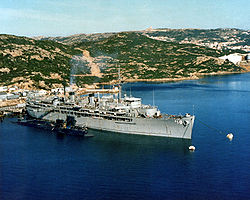 Former Santo Stefano's NATO Naval Base
Former Santo Stefano's NATO Naval Base
The economic crisis and unemployment aggravated the crime rate, as evidenced by the increasing frequency of phenomena such as kidnappings and political subversion: between the 1970s and the early 1980s, some communist groups, the most famous were Barbagia Rossa, and the Sardinian Fighting Movement (MAS), claimed several terrorist attempts.
In the 1983 for the once a militant of an autonomist party, the Sardinian Action Party (Partito Sardo d'Azione), was elected president of the regional parliament. Neverteless in the 1980s several independence movements were born, evolving into parties in the 1990s. In 2006, the first independentist was elected to public office in the Province of Sassari. In 1999 the local languages was granted co-official status alongside the Italian language.
Sardinia's history is still visible in language and culture. Also noticeable is the difference between coastal regions and the inland. Coastal regions have always been more open to outside influences. Nowadays Sardinia is most known for its coasts (La Maddalena, Costa Smeralda), the north-western coast near Sassari (Alghero, Stintino, Castelsardo) and Cagliari, because these are easily reachable by ship and by plane.
Today Sardinia is a phasing-in EU region, featured by a diversified economy, mainly focused on tourism and the tertiary, the economic efforts of last twenty years have reduced the handicap of insularity, for example with low cost air companies and information and informatic technologies, thanks to the CRS4 (Center for Advanced Studies, Research and Development in Sardinia), which developed the first Italian website, and invented the webmail, in 1995, that brought to the birth of several telecommunication companies and internet service providers based on the island, as Video On Line, in 1993, Tiscali, in 1998 and Andala UMTS, in 1999.
See also
Notes
- ^ C.M.Hogan, 2008
- ^ Stephen L. Dyson and Robert J. Rowland, Archaeology And History In Sardinia From The Stone Age To The Middle Ages: Shepherds, Sailors, & Conquerors (UPenn Museum of Archaeology, 2007: ISBN 1934536024), p. 101 (with refs).
- ^
 "Sardinia". Catholic Encyclopedia. New York: Robert Appleton Company. 1913.
"Sardinia". Catholic Encyclopedia. New York: Robert Appleton Company. 1913. - ^ Ptol. III, 3.
- ^ R.J.Rowland, 1982.
References
- Francesco Casula, "The History of Sardinia." Sardinia Tourist Board. 1989.
- C. Michael Hogan, Cydonia, Modern Antiquarian, January 23, 2008 [1]
- John C. Moore, "Pope Innocent III, Sardinia, and the Papal State." Speculum, Vol. 62, No. 1. (Jan., 1987), pp 81–101.
- Laura Sannia Nowé, . Dai "lumi" dalla patria Italiana: Cultura letteraria sarda. Modena: Mucchi Editore, 1996.
- Robert J. Rowland Jr., "The Sardinian Condaghi: Neglected Evidence for Mediaeval Sex Ratios." Florilegium, Vol. 4 (1982), pp. 117–122.
- D. Scano, "Serie cronol. dei giudici sardi." Arch. stor. sardo. 1939.
- A. Solmi, Studi storici sulle istituzioni della Sardegna nel Medioevo. Cagliari: 1917.
External links
Categories:- History of Sardinia
- History of Italy by location
Wikimedia Foundation. 2010.

